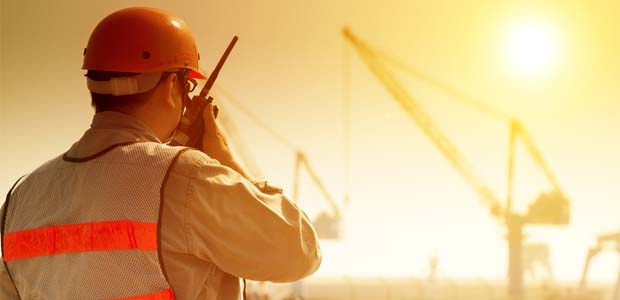
Creating a Culture of Safety
Keeping safety top of mind is embedded within today's construction organizations and starts with strong leadership.
- By Lauren Tosti
- Jul 01, 2018
In today's competitive construction market, we need leaders who build sustainable cultures where safety and health are woven seamlessly into the fabric of the organization alongside efficiency, quality, and productivity. It's no secret that leaders create culture, culture shapes attitudes and behaviors, and attitudes and behaviors influence outcomes.
The safety and well-being of every employee and job site comes first and foremost. Beyond this, a lack of safety awareness and compliance also has business consequences. Each year, accidents on the work site pull from the contractor's bottom line. The direct cost of accidents is found in insurance premiums, deductibles, and direct payments.
Safety always has been an integral part of the construction industry, and today it has evolved into a resource for competitive organizations to become more efficient while simultaneously offering cost-reducing measures that benefit their business.
In addition, safety is no longer limited to compliance alone. When compliance is the marker, "your maximum success is tied to achieving minimal results," said Jeffrey A. Spatz, assistant vice president, safety services, for Graham Company, located in Philadelphia. "Are you measuring the lack of failures or the presence of positive actions? Focus on what you want more of, rather than what you want less of."
Empowering Leaders: A Three-Pronged Approach
Safety leadership should be approached like any other business training—leaders become equipped with the best skills and tools for success. The approach can be boiled down to three key areas:
- Leadership methodologies: What are your leadership qualities? How can these be translated and leveraged in order to promote a culture of safety?
- Effective communication skills: What are the ways and means of communicating with positive results? Which communication method or style is appropriate for the situation?
- Team building and the value of a strong team leader: How do teams interact? What role can a leader play in building and empowering teams to take an organization to new heights?
Cultivating Your Safety Program
A leader's personality and management approach impacts the entire day-to-day operations of a construction business, including the methods in which safety protocols are introduced, communicated, and enforced. Everyone has a different leadership style.
What's most important for all leaders to recognize is that their influence is not their position. A leader's actions while on the job are far more significant than his or her assigned rank or title within an organization. Lead by example, always.
For Jim Ryan, corporate safety director at INTECH Construction, LLC, of Philadelphia, safety is "the constant." He added, "We stress safety first at every meeting, from the very first scope to the preinstall meetings with the subcontractors, to the post-mortem meeting in house when the job is complete."
Effective leadership requires respect from your peers, your direct reports, and upper management. When it comes to earning respect, there a few key values: integrity, courage, passion, vision, and sacrifice. Once a leader cultivates these key ingredients, the recipe for respect is made.
Communicating Effectively
Values are also intrinsic to the communication of safety principles. Consistency of these values is one factor that will determine the success of your safety program, said Dennis Dougherty, president of Med-Tex Services, Inc., in Philadelphia. Clear goals and expectations, education, enforcement, and follow-through are all hallmarks of effective safety communication. That means that your workers are taught what to look for and understand the consequences if safety protocols are not followed; they are also encouraged to share safety concerns, feedback, and the reporting of incidents.
Communication isn't all talk, either. Leaders need to make sure safety skills are honed on the job, not just in the classroom. Today's construction safety training programs have moved well beyond PowerPoint methodology, said Dougherty. For example, leaders should demonstrate how to hold harnesses and related equipment, not just show photos of the right and wrong way to perform an action.
Communication practices also need to account for multilingual challenges, noted Hoyt Emmons, senior consultant for Med-Tex Services, Inc. "A simple example is training a non-English speaker in first aid, CPR, or choking," he explained. "They may not get all the words, they can get the concepts. They practice, and then they can—and do—save lives."
"Teams that are focused on the success of the group, company, or project as a whole will communicate well," said Dougherty. "Sharing information, ideas, and updates and requesting support in areas that are challenging keep a well-oiled machine. When personal agendas or selfish considerations are introduced, the team may stumble to reach the desired outcome due to those distractions."
Positioning Teams for Success
Safety shouldn't stop at the top of the organization's ladder. A safety leader sets the tone for a culture of safety within the entire company, leading by example and inspiring others to follow suit and take action, whether they're in the office or on the job site.
Further, leadership should never be limited by title. All hands need to be on deck. A good leader will instill the qualities and skills they have learned into others, so that all employees are empowered to become stewards of safety in their own right.
"Developing and maintaining a safety culture is the foundation of who we are," said Bill Reis, safety director at Belcher Roofing Corporation in Montgomeryville, Pa. "Once that culture is created and valued by all members of our team, everything else gets simple. We discuss, plan, and execute on safety every day. You will never hear the question why we need a safety plan, but how we can create a safety plan for each task."
Added Reggie Asare, EHS manager at Skanska USA Building Inc., "Your loved ones expect you to come home safely—so do we."
This article originally appeared in the July 2018 issue of Occupational Health & Safety.